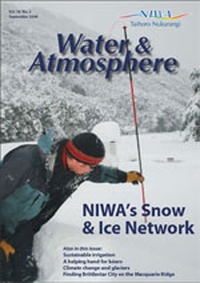News: Native species of Te Arawa lakes - NZ beaches get the layered look
Resources from the website: an information sheet about the factors that influence kōura in the Te Arawa lakes. (Graphic: Aarti Wadhwa)
Native species of Te Arawa lakes
NIWA and the Te Arawa Lakes Trust are developing a sustainable management plan for Te Arawa’s customary fisheries. We’re putting together tools, monitoring methods, and guidelines that focus specifically on culturally important mahinga kai and taonga species. By grounding our work in customary knowledge and sound scientific principles, we’re helping Te Arawa to manage their lakes’ noncommercial fisheries sustainably and in a manner consistent with their tikanga and kawa.
Our new website is an information resource for five key species:
- kōura (freshwater crayfish, Paranephrops planifrons)
- kākahi (freshwater mussel, Hyridella menziesi)
- kōaro (freshwater fish, Galaxias brevipinnis)
- common smelt (Retropinna retropinna)
- tuna (shortfin and longfin eels, Anguilla australis and Anguilla dieffenbachii).
Pages on these species offer, for the first time, integrated information encompassing both scientific and cultural knowledge.
The website also introduces the major aims of the Te Arawa Lakes project and describes the key research components. You can download reports on current knowledge of species, graphics of conceptual models, and pages about ‘what-if?’ scenarios associated with water management issues. There are links to additional resources, such as an explanation of the Te Arawa Lakes Regulations.
By making these resources available to the wider community, we aim to spread the word about the cultural and scientific significance of these species and their specific management requirements.
This project is funded by the Foundation for Research, Science and Technology.
Visit the new website at: www.niwascience.co.nz/maori/research/te_arawa_lakes
For further information, contact:
Dr Ngaire Phillips, 0-7-856 1772, [email protected]
New Zealand beaches get the layered look
NIWA’s new Coastal Explorer web tool provides layers of free information about New Zealand’s shoreline and beaches. Its purpose is to help people understand beaches, manage coastal hazards, and safeguard lives and property.
Using GIS-based maps, Coastal Explorer lets you investigate beach and coastal features such as tides, waves, foreshore sediment type, coastal bathymetry, and hinterland topography. We’re gradually adding detailed fact sheets about specific beaches to the Explorer’s database. These include 3-D models showing the beach type and characteristics of waves and rips, details of access and beach facilities, and photos of the beach. With the assistance of Surf Life Saving New Zealand, we’ve assigned a safety rating for each beach.
Coastal Explorer will be of value to resource managers, scientists, surf lifeguards, local communities, and people just heading out for a day at the beach.
The website has been developed with funding from the Foundation for Research, Science and Technology.
Visit Coastal Explorer at: wrenz.niwa.co.nz/webmodel/coastal
For further information, contact:
Dr Terry Hume, 0-7-856 1729, [email protected]



